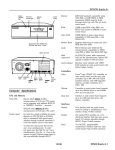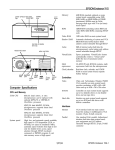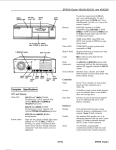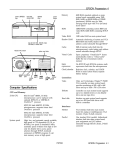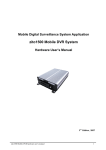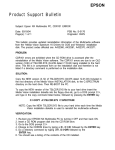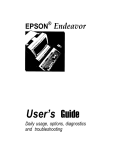Download Epson Endeavor 486C Specifications
Transcript
EPSON Endeavor 486C To select slow speed, press the Ctrl, Alt, and - keys simultaneously. To select fast speed, press the Ctrl, Alt, and + keys simultaneously. (Use the - or + key on the numeric keypad.) Default system speed is also user-selectable through SETUP power button Memory 4MB RAM standard; expandable using 1MB, 4MB, or 16MB SIMMs to 36MB (maximum); SIMMs must be 36-bit, fast-page mode type with 70ns (or faster) access speed ROM 128KB system BIOS, video BIOS, and SETUP code located in EPROM on main system board Video RAM 512KB DRAM on main system board, expandable to 1MB using 256k x 4-bit DRAM ZIPS Shadow RAM Supports shadowing of system and video BIOS ROM into RAM Cache 8KB of internal cache (built into the microprocessor); expandable to 256KB using 8KB or 32KB, 70ns SRAM DIP chips Math coprocessor On 4DX/33C and 4DX2/50C systems, math coprocessor built into the microprocessor; optional 487 upgrade available for 4SX/25C system Clock/calendar Real-time clock, calendar, and CMOS RAM socketed on main system board with built-in battery backup bay for hard disk, diskette drive, CD-ROM, tape drive, or other option card slots Controllers Computer Specifications Video Cirrus® Logic GD5422 VGA controller on main system board; provides true color resolutions up to 800 x 600 with 512KB standard memory; with 1MB upgraded memory, provides resolutions up to 1280x1024 Diskette Controller on main system board supports up to two diskette drives or one diskette drive and one tape drive Hard disk Interface on main system board supports up to two IDE hard disk drives with built-in controllers CPU and Memory 32-bit CPU 4SX/25C: Intel i486SX, 25 MHz microprocessor in PGA-type CPU socket; can be upgraded with optional 487SX/25 or ODP486-25 OverDrive™ processor 4DX/33C: Intel i486DX, 33 MHz microprocessor in PGA-type CPU socket; can be upgraded with optional ODP486-33 OverDrive processor 4DX2/50C: Intel i486DX2, 50 MHz microprocessor in PGA-type CPU socket System speed Fast and slow speeds available; fast speed depends on CPU (25 MHz, 33 MHz, or 50 MHz), slow speed is simulated 8 MHz speed; speed selection through keyboard command; 0 wait state memory access at fast speed Interfaces Monitor 7/15/93 VGA interface built into main system board for analog or multifrequency VGA monitor; 15-pin, D-shell connector EPSON Endeavor 486C-1 EPSON Endeavor 486C Parallel One standard S-bit parallel, uni- or bidirectional interface built into main system board; I/O address selectable through SETUP; 25-pin, D-shell connector Video Modes Mode VGA Extended, 512KB memory required Serial Two RS-232C, programmable, asynchronous interfaces built into main system board; 9-pin, D-shell connectors Keyboard PS/2 compatible keyboard interface built into main system board; num lock setting selectable through SETUP; 6-pin, mini DIN connector Mouse PS/2 compatible mouse interface built into main system board; 6-pin, mini DIN connector Option slots Four 16-bit (or 8-bit) I/O expansion slots, ISA compatible, 8 MHz bus speed; three slots accommodate any size card, bottom slot can hold reduced size card (4.4 inch/110 mm) Speaker Internal, piezo-electric speaker on main board VGA feature connector Hard disk drives Other devices Keyboard SETUP Program 640x480 640x480 640 x 480 640x480 800x600 800x600 640x480 800x600 Power Supply 185 watt, fan-cooled 19Oto2WVAC 1+5VDCatllAmps, +12 VDC at 2.0 Amps, -5 VDC at 0.3 Amps, -12 VDC at 0.3 Amps 47 to 63 Hz Input ranges Maximum outputs Frequency 1 Option Slot Power Limits IBM compatible VGA pass-through interface built into main system board; 26-pin connector Maximum current For each slot For all four slots +5 volts 7 Amps 11 Amps +12 volts 1.5 Amps 2 Amps -5 Volts and -12 Volts 0.3 Amps 0.3 Amps Environmental Requirements Mass Storage Diskette drives Extended, 1 MB memory required Resolution Condition Three half-height drives maximum configurable using the following: 5.2!S-inch, 1.2MB (high-density) capacity 3.5-inch, 1.44MB (high-density) capacity 5.25-inch, 360KB (double-density) capacity 3.5-inch, 720KB (double-density) capacity Dual diskette drive: 3.5-inch, 1.44MB and 5.25-inch, 1.2MB a&Inch form factor hard disk drive(s). up to half-height size; the first mounted vertically, second mounted horizontally Half-height tape drive, CD-ROM, or other storage device; 5!Nnch or Sl&lnch with mounting frames Temperature Humidity (noncondensing) -330 to 9,900 ft (-100 to 3,00m) Maximum 68°F wet bulb (20° C) Acoustical 37.5 dB(A) Altitude Detachable, two-position height; 101 or 102 sculpted keys; country-dependent main typewriter keyboard; numeric/cursor control keypad; four-key cursor control keypad; 12 function keys Non-operating range -4° to 140° F (-20° to 60° C) 10% to 90% Storage range -4° to 140° F (-20° to 60° C) 10% to 90% -330 to 39,600 ft (-100 to 12,000m) 104°F (40° C) N/A -330 to 39,600 ft (-100 to 12,000m) 134°F (57° C) N/A Physical Characteristics Width Depth Height Weight Stored in ROM; accessible by pressing the Delete key at the SETUP prompt during boot EPSON Endeavor 486C-2 Operating range 41° to 90° F (5° to 32° C) 20% to 90% 7/15/93 14.8 inches (370 mm) 16.5 inches (412 mm) 4.8 inches (120 mm) 16.7 b (7.5 kg), with one diskette drive and one hard disk, but without keyboard EPSON Endeavor 486C Main System Board Diagram 7/15/93 EPSON Endeavor 486C-3 EPSON Endeavor 486C Major Subassemblies Serial Port Connectors (CN9 and CN10) Serial Port Connector Pin Assignments Keyboard Connector (CN5) and Mouse Connector (CN4) Connector Pin Assignments Parallel Port Connector (CN8) Although the keyboard and mouse connectors are physically identical, they cannot be used interchangeably. Keyboard and Mouse Connector Pin Assignments Pin 1 2 3 Signal Data Resewed Ground Pin 4 5 6 VGA Port Connector (CN13) Parallel Port Connector Pin Assignments VGA Port Connector Pin Assignments * Active low logic EPSON Endeavor 486C-4 7/15//93 Signal +5VDC (fused) clock Reserved EPSON Endeavor 486C VGA Feature Connector (CN14) System l/O Address Map VGA Feature Connector Pin Assignments *Active low logic DMA Assignments Level DMA0 DMA1 DMA2 DMA3 DMA4 DMA5 DMA6 1 DMA7 Assigned device Spare (8-bit) Spare (8-bit) Diskette drive controller (8-bit) Spare (8-bit) Cascade for DMA controller Spare (16-bit) spare (16-bit) 1 spare (16-bit) Hardware Interrupts IRQ no. IRQ0 IRQ1 IRQ3 IRQ4 1 IRQ5 1 IRQ6 IRQ7 IRQ8 IRQ9 IRQ10 IRQ11 IRQ12 IRQ13 IRQ14 IRQ15 Function Timer output Keyboard Serial port 2 Serial port 1 1 Available parallel port 2) I FDD controller 1 Parallel port 1 I Real-time clock Available Available Available PS/2 compatible mouse, optional pointing devices Math coprocessor HDD controller Available I 7/15/93 EPSON Endeavor 486C-5 EPSON Endeavor 486C Hard Disk Drive Jumper Settings System Memory Map 23FFFFF 36MB lf CS (cable selection) is jumpered, the drive is a master if pin-28 is grounded and a slave if pin-28 Is not grounded. l DIP Switch Settings Switch 1** Setting ON OFF ON 2** Off 3** ON Off 4 ON’ Off ON’ 5 Off * Factory setting Extended memory 0100000 I 1MB System BIOS (Shadow RAM, 64KB) OOFOOOO l 33 MHz CPU speed 25 MHz CPU speed 25 MHz CPU speed 33 MHz CPU speed CPU present in PGA socket CPU absent from PGA socket Enable password security feature Disable password security feature Select color monitor Select monochrome monitor * Factory set according to system type Reserved for system BIOS (64KB) 00E0000 Processor Chips Reserved for ROM on l/O cards 00C7FFF The 4SX/25C or 4DX/33C systems can be upgraded with an Intel OverDrive processor on the main system board to effectively double the internal clock speed of the computer’s microprocessor. Alternatively, the 4SX/25C accepts the Intel 487SX/25 microprocessor with built-in math coprocessor. VGA BIOS ROM (Shadow, 32KB) VGA Color Text 00B8000 VGA Mono Text 00B0000 VGA Graphics 00A0000 Base memory OverDrive Processors 640KB OverDrive processor ODP486-25 ODP486-33 Jumper and DIP Switch Settings SIMM Installation Display Adapter and CPU Jumper Settings Jumper J3 Setting A* B J4 A** B * Factory setting l Function Enable the built-in VGA adapter Disable the built-in VGA adapter so you can use a display adapter on an option card as your primary 1 adapter Select DX or DX2 CPU Select SX CPU * Factory set according to system CPU External Cache Jumper Settings * The computer comes with 4MB of memory on the main system board. To increase the amount of memory in the computer up to 36MB, install 36-bit, fast-page mode SIMMs that operate at an access speed of 70ns or faster, with a capacity of 1MB, 4MB, or 16MB. The following table shows the possible SIMM configurations; do not install memory in any other configuration. SIMM Configurations Factory setting; change jumpers only if external cache chips am Installed Standard memory on the system board ** SIMMs can occupy either socket l EPSON Endeavor 486C-6 7/15/93 EPSON Endeavor 486C Video Memory Hard Disk Drive Types If the computer has 512KB of video memory, you can install four 256K x 4 bit, 70ns, 20-pin DRAM ZIP (Zig-zag Inline Package) chips to increase the video memory to 1MB. The following table lists compatible DRAM ZIP chips. The table below lists types of hard disk drives supported by the computer. Check this table and the hard disk manual to find the correct type number(s) for the hard disk drive(s) installed in the computer. Enter the type number(s) when you set the hard disk drive configuration in the SETUP program. Supported Video ZIP Chips Hard Disk Drive Types Cache Memory Additional cache memory can be installed in eight sockets in Bank 0 and Bank 1 on the main system board. The figure below shows how the SRAM are distributed. 8KB or 32KB SRAM chips can be installed. Bank 0 must be filled before Bank 1. The SRAM type used for RAM in locations U15 and U16 must match the type installed in the banks. The table below shows the possible configurations. Cache Memory Configuration 7/15/93 EPSON Endeavor 486C-7 EPSON Endeavor 486C Installation/Support Tips Password 0 Make sure that you do not forget the password you set up. Mouse and Keyboard If you do: 0 When connecting the mouse and keyboard to the computer, be careful to plug them into the proper ports. Although the ports are physically identical, they are not interchangeable, and damage may occur to the main system board if you plug the connectors into the wrong ports. 1. Disable it by setting DIP switch 4 on the main system board to OFF. Installing Diskette Drives 2. Then turn the computer on and off again. 3. Set DIP switch 4 to ON to enable the password function. 4. Run SETUP to enter a new password, if desired. P Users can enter a hot key designation in SETUP to secure the system from unauthorized users. Once a password and hot key have been set, when the hot key is pressed, the keyboard and mouse lock until the user enters the password. P Make sure that the drive type has been correctly selected in the SETUP program. Installing Hard Disk Drives It is recommended that a 16-bit, AT-type hard disk controller be used if you are installing a drive that cannot use the embedded IDE interface. If you install a non-IDE hard disk drive and controller card, you need to use the SETUP program to disable the built-in IDE hard disk drive interface. When installing a hard disk drive, see the hard disk drive types table on page 7 and use the SETUP program to select the correct type number for the drive. You can select a type number that matches the parameters for the drive or a type number with parameters having lesser values, as long as they do not exceed the maximum capacity (in MB) of the drive. If there is no match for the drive, you can select a user-defined drive type (47) and enter the drive’s exact parameters. Software Problems Cl When installing a copy-protected software package, first try the installation at fast speed. If this does not work properly, select slow speed by pressing the Ctrl and Alt keys and the - key on the numeric keypad simultaneously. Try loading the program at slow speed and then switching to fast speed, if possible. 0 When using a software package that uses a key disk as its copy-protection method, try loading it at fast speed. If this does not work, load it at slow speed. EPSON Endeavor 486C-8 Booting Sequence Cl If you cannot boot the computer from the hard disk drive, make sure the booting sequence in the SETUP program is set to A, C. Then boot the computer from a system diskette in drive A. Information Reference List Engineering Change Notices None. Technical Information Bulletins None. Product Support Bulletins None. Related Documentation TM-ENDVR4C Epson Endeavor 486C Service Manual PL-ENDVR4C Epson Endeavor 486C Parts Price List SPKENDVR4C Epson Endeavor 486C Self Paced Kit 400230800 Epson Endeavor 486C User’s Guide 7/15/93








